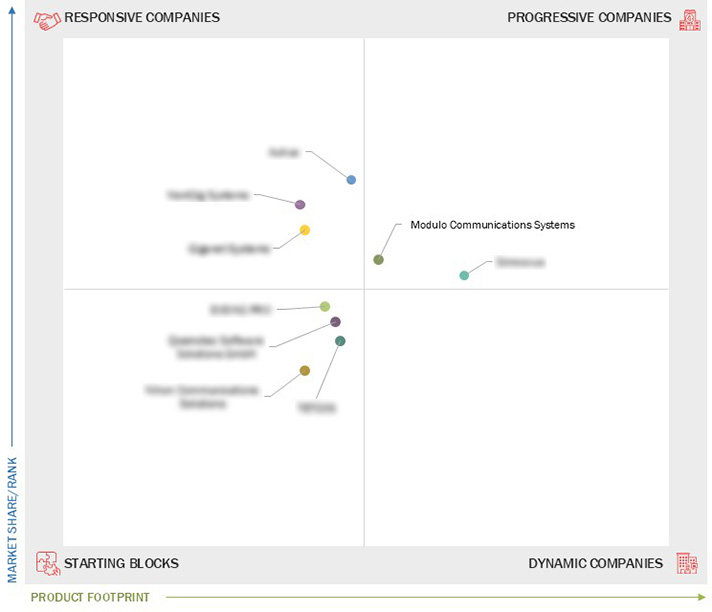Comparing 9 vendors in Network Emulator Startups across 0 criteria.
Network emulators are becoming essential tools as virtualization and software-defined networking gain traction. They allow testing of network setups in virtual environments, helping assess performance and user experience before deployment. Unlike simulators, emulators replicate real-world conditions more accurately, enabling better decision-making. They can simulate impairments like delay and packet loss, making them valuable for engineers and developers. The market is expanding due to rising demand, security concerns, and technological advancements, though challenges like skill gaps and evolving requirements persist.
Market Leadership Quadrant
1.1 Study Objectives
1.2 Market Definition
1.3 Study Scope
1.3.1 MSegments Considered and Regional Scope
1.3.2 Inclusions and Exclusions
1.3.3 Years Considered
1.4 Currency Considered
1.5 Unit Considered
1.6 Limitations
1.7 Stakeholders
2.1 Introduction
2.2 Market Dynamics
2.2.1 Drivers
2.2.1.1 Rise of attacks and security breaches on networks
2.2.1.2 Rise in virtualization and cloud adoption
2.2.1.3 Need for reduced downtime in networking
2.2.2 Restraints
2.2.2.1 Longer timelines and extended R&D requirements for new networking technologies
2.2.2.2 Price sensitivity of network testing and emulators
2.2.3 Opportunities
2.2.3.1 Increasing demand for software-defined networking and virtualization
2.2.3.2 Multi-protocol support and advanced functions provided by same hardware emulator
2.2.3.3 Investments in R&D and positive outcomes from testing phase of 5G networks
2.2.4 Challenges
2.2.4.1 Lack of skilled workforce to comprehend and report issues in networking
2.2.4.2 Fast-changing network requirements to pose challenge for emulators
2.3 Trends/Disruptions Impacting Customer Business
2.4 Value Chain Analysis
2.5 Ecosystem Analysis
2.6 Investment and Funding Scenario
2.7 Technology Analysis
2.7.1 Key Technologies
2.7.2 Complementary Technologies
2.7.3 Adjacent Technologies
2.8 Patent Analysis
2.9 Trade Analysis
2.10 Porter’s Five Forces Analysis
2.10.1 Threat of New Entrants
2.10.2 Threat of Substitutes
2.10.3 Bargaining Power of Suppliers
2.10.4 Bargaining Power of Buyers
2.10.5 Intensity of Competitive Rivalry
3.1 Introduction
3.2 Key Player Strategies/Right to Win
3.3 Revenue Analysis
3.4 Market Share Analysis
3.5 Company Valuation and Financial Metrics
3.6 Brand/Product Comparison
3.7 Company Evaluation Matrix: Startups/SMEs
3.7.1 Progressive Companies
3.7.2 Responsive Companies
3.7.3 Dynamic Companies
3.7.4 Starting Blocks
3.7.5 Competitive Benchmarking: Startups/SMEs
3.7.5.1 Detailed list of key startups/SMEs
3.7.5.2 Competitive benchmarking of key startups/SMEs
3.8 Competitive Scenario
3.8.1 Product Launches
3.8.2 Deals
4.1 Simnovus
4.1.1 Business overview
4.1.2 Products/Solutions/Services offered
4.1.3 Recent developments
4.2 Modulo Communications Systems
4.2.1 Business overview
4.2.2 Products/Solutions/Services offered
4.2.3 Recent developments
4.3 Aukua
4.3.1 Business overview
4.3.2 Products/Solutions/Services offered
4.3.3 Recent developments
4.4 NEXTGIG SYSTEMS
4.4.1 Business overview
4.4.2 Products/Solutions/Services offered
4.4.3 Recent developments
4.5 GIGANET SYSTEMS
4.5.1 Business overview
4.5.2 Products/Solutions/Services offered
4.5.3 Recent developments
4.6 EVE-NG PRO
4.6.1 Business overview
4.6.2 Products/Solutions/Services offered
4.6.3 Recent developments
4.7 Qosmotec Software Solutions GmbH
4.7.1 Business overview
4.7.2 Products/Solutions/Services offered
4.7.3 Recent developments
4.8 Nihon Communications Solutions
4.8.1 Business overview
4.8.2 Products/Solutions/Services offered
4.8.3 Recent developments
4.9 TETCOS
4.9.1 Business overview
4.9.2 Products/Solutions/Services offered
4.9.3 Recent developments



